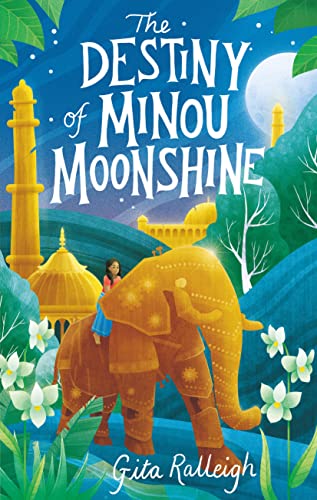The Destiny of Minou Moonshine
Thirteen-year-old Minou is a foundling who lives with her adopted grandmother Dima on a dilapidated houseboat in the bend of a river in Moonlally, formerly a queendom, but now ruled by an autocratic general. A startling change in her circumstances forces Minou to use her intuition as to who is friend or foe and leads to her joining a rebel group, the Green Orchids.
In this historical fantasy, the place names are invented, although the map of ‘Indica’ at the beginning of the book clearly suggests the shape of southern India, and connections with India are evoked in several ways. These include flora and fauna – elephants (real and mechanical!) play a significant role (see Weitong Mai’s glittering cover for indication of this), as do crocodiles and bats. Characters are skilled in kalari, an existing martial art originating in Kerala. Clothing is culturally referenced, for example dhotis and saris, contrasting with ballgowns of gold silk or tussore decorated with red jewels for the trousseau of the General’s daughter, Ophelia.
The division and power imbalance between Blacktowners and Whitetowners is highly suggestive of the colonial connections between Europe and India. Ophelia is being sent to Lutetia (a previous name for Paris); her teacher is called Mamzelle. Minou is also known as Sparrow, and her name is close to moineau, French for sparrow. There is an airship named Napoleon, and while the date is never mentioned, the inclusion of this invention suggests a time frame of the 1850s onwards. Figures from Hindu mythology such as the elephant-headed god are mentioned but rarely by name.
An exciting fantasy adventure with an engaging heroine imbued with details that enable readers to draw parallels with historical events if they wish. As the graveyard poet Farisht says: ‘Stories matter, A land that loses its stories loses its way.’










